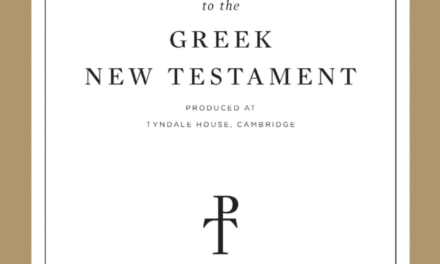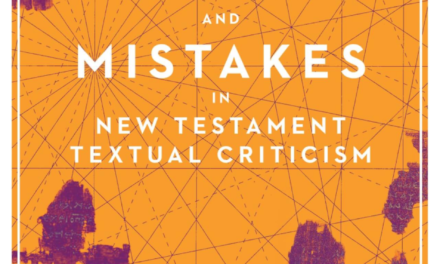Daniel Wallace
“… I don’t hold to the doctrine of preservation. That doctrine, first formulated in the Westminster Confession (1646), has a poor biblical base. I do not think that the doctrine is defensible –either exegetically or empirically. As Bruce Metzger was fond of saying, it’s neither wise nor safe to hold to doctrines that are not taught in Scripture.”
Source: Perspectives on the Ending of Mark, pg. 118 (SCRIBD free preview)

As an Amazon Associate, we may earn from qualifying purchases.




I question Daniel Wallace’s statement that the doctrine of preservation has a poor biblical base.
In addition to my earlier comment, when Daniel Wallace states that “that doctrine [of preservation], first formulated in the Westminster Confession (1646), has a poor biblical base,” he is making two claims:
Claim 1: The doctrine of preservation was first formulated in the Westminster Confession.
Claim 2: The doctrine of preservation has a poor biblical base.
CLAIM 1
How did Wallace arrive at this claim? It was probably based on the statements he had made in an earlier paper: “The doctrine of preservation was not a doctrine of the ancient church. In fact, it was not stated in any creed until the seventeenth century (in the Westminster Confession of 1646)” (Wallace 1991, 41-42). Samuel T. L. Eio’s comment bears out the damage wreaked by Wallace’s statements:
“Denying flat-out any doctrine of Biblical preservation is well-known evangelical New Testament scholar Daniel B. Wallace, who asserted that (1) no doctrine of Biblical preservation predated the Westminster statement; and that, (2) by implication, the Westminster Divines’ idea of Scripture’s preservation (amounting to a novel doctrine previously unheard of) together with their citing as proof text Matthew 5:18, was something the members of that illustrious Assembly had most PROBABLY engineered at the spur of the moment sometime around 1646” (Eio 2014, 3).
For the question of whether Wallace’s statements are historically valid, the reader may refer to Eio’s master’s thesis (Eio 2014, 28-50).
CLAIM 2
As for the question of whether Claim 2 is true, the reader may refer to my book for further study (Yip 2022, 38-97). The book establishes biblically that God providentially preserves every one of his words for every subsequent generation. Five major Bible passages are adduced as proof: Ps. 12:7, Mt. 4:4, Ps. 119:89, Is. 40:8, and 1 Pet. 1:23.
But has Wallace considered the afore-mentioned Bible passages? He has considered three of them – Ps. 119:89, Is. 40:8, and 1 Pet. 1:23.
Ps. 119:89/Is. 40:8
Highlighting that preservationists cannot automatically assume that any reference to “God’s Word” is to be identified with his written revelation, Wallace has suggested that a better interpretation of Ps. 119:89 and Is. 40:8 would be that they are “statements concerning … the promise of fulfilled prophecy” (Wallace 1991, 42). What is Wallace saying here? With regard to Ps. 119:89, it appears that Wallace is saying that the Psalmist has asserted the sure fulfillment of God’s prophecies when he stated that the LORD’s word is settled (or stands) in heaven. A similar point may be made with regard to Is. 40:8. Here it appears that Wallace has interpreted the verb “stand” in that verse to mean “be fulfilled.” Let us proceed to examine each point in turn.
First, Ps. 119:89. Since, as Wallace points out, it cannot be automatically assumed that any reference to “God’s Word” is to be identified with his written revelation, we will begin by asking what “thy word” (Heb. dabar) in Ps. 119:89 refers to. To begin with, it should be noted that the Psalmist used the synonyms “ordinances,” “law,” “precepts,” “testimonies,” and “commandment” in the same Lamed strophe (verses 89-96), all of which refer to God’s written word or, specifically, the entire written Torah of God. Harold L. Willmington writes, “The psalmist gives the Bible nine titles in this Psalm [Psalm 119]. … The nine titles [are] (1) his law (v. 1) (2) his testimonies (v. 2) (3) his ways (v. 3) (4) his precepts (v. 4) (5) his statutes (v. 5) (6) his commandments (v. 6) (7) his righteous judgments (v. 7) (8) his Word (v. 9) (9) his ordinances (v. 91)” (Willmington 1984, 123). And J. J. Stewart Perowne writes, “The law … must obviously have been the written law” (Perowne 1876, 2:330). Thus, “thy word” in Ps. 119:89 refers to God’s written communication.
There is another reason why “thy word” in Ps. 119:89 refers to God’s written communication. Moving beyond the immediate context of the verse, we can find numerous parallel passages in the SAME chapter (Psalm 119) where the Hebrew dabar was used, and this term refers to God’s written word. George Skariah gives the examples of Ps. 119:81 and Ps. 119:105 (Skariah 2005, 180). The former verse says, “My soul fainteth for thy salvation: but I hope in thy word [dabar].” The latter verse says, “Thy word [dabar] is a lamp unto my feet, and a light unto my path.” Surely, the Hebrew dabar in these and other examples refer to God’s written communication. Specifically, it refers to the written Torah of God.
We have shown that “thy word” in Ps. 119:89 refers to the written word – the written Torah. When we therefore say, “Thy WRITTEN WORD is settled (or stands) in heaven,” the verse would tend more to the INDESTRUCTIBILITY of God’s written word in heaven than to the SURE FULFILLMENT of his prophecies – the Torah stands, and it cannot be destroyed. This is in contradistinction to Wallace’s interpretation that the Psalmist has asserted the certain fulfillment of God’s prophecies. When we subsequently say, “FOR EVER, O LORD, thy written word is settled in heaven,” we are speaking of the indestructibility of the written word in heaven from eternity past to eternity future. If the written word is eternally indestructible, it must be eternally preserved.
One may say that the preservation is only in heaven. But the Psalmist wrote in verse 92 that “thy word” in heaven (he called it by the synonym “thy law”) was “not something that is strange to him, but always has been his delight; otherwise he would have perished in his affliction” (Skariah 2005, 183-184). The Torah, which is eternally preserved in heaven, was also available to him on earth.
Let us now move on to Is. 40:8. We begin, once again, by identifying “the word of our God” in Is. 40:8. We would do well to apply the principle of “Scripture interprets Scripture” – looking at the context of the entire Scripture to understand the particular passages of Scripture. Now in 1 Pet. 1:24-25, the Apostle Peter quoted Is. 40:6-8, saying, “For all flesh is as grass, and all the glory of man as the flower of grass. The grass withereth, and the flower thereof falleth away: But the word of the Lord endureth for ever.” Then Peter added, “And this is the word which by the gospel is preached unto you.” In other words, the Gospel was not something new, but it was already there in “the word of the Lord” (or “the word of our God” in Is. 40:8). What then is “the word of the Lord”?
Skariah is probably right when he says that “the word of the Lord” refers to the written Old Testament (Skariah 2005, 210). He cites the Apostle Paul as saying in a parallel passage,
“Moreover, brethren, I declare unto you the gospel which I preached unto you, which also ye have received, and wherein ye stand; By which also ye are saved, if ye keep in memory what I preached unto you, unless ye have believed in vain. For I delivered unto you first of all that which I also received, how that Christ died for our sins according to the scriptures; And that he was buried, and that he rose again the third day according to the scriptures” (1 Cor. 15:1-4).
To err on the side of caution, let us just restrict “the word of the Lord” to the Nevi’im – the words of God written through the Old Testament Prophets.
It must be remembered that “the word of the Lord” was not preached by the Prophets themselves, but by Jesus and his disciples hundreds of years later. Jesus and his disciples must have relied on the words of God WRITTEN through the Prophets for their preaching.
Let us now look at the meaning of “stand” in Is. 40:8. By way of recapitulation, Wallace has interpreted the verb “stand” in that verse as “be fulfilled.” Isaiah was obviously using the word “stand” in a figurative sense. However, the verb “stand” here means endurance, not fulfillment. As Skariah points out, the immediate context of the verse shows a contrast between the transience of “the grass” and “the flower” and the endurance of the word of God (Skariah 2005, 200). Isaiah emphasized the endurance of God’s word IN CONTRAST to grass and flowers. Hence Wallace has incorrectly interpreted the word “stand” in Is. 40:8 to mean “be fulfilled.”
If we go on to say, as Isaiah did, that the word of God would endure FOREVER (“shall stand for ever”), this would imply the preservation of the word of God (the Nevi’im as shown earlier) into eternity future – God has preserved it since the time it was inscripturated and he will preserve it forever.
1 Pet. 1:23-25
But an objection may raised at this point. Has Wallace not pointed out that 1 Pet. 1:24-25, in quoting Is. 40:8, uses the Greek term rhéma for “word,” which is “a term which typically refers to the spoken word”? (Wallace 1991, 42). In response, it must be noted that there is a change in the Greek term for “word” from 1 Pet. 1:23 to 1 Pet. 1:25 – from logos of verse 23 to rhéma of verse 25. I submit to the reader that logos is the written Nevi’im, and Peter changed it to rhéma in verse 25 to indicate that the written Nevi’im was SPOKEN (“preached”) to his readers. The word [logos] of God in 1 Pet. 1:23 was changed to rhéma in verse 25 for this purpose.
The same change is found in Acts 10:36-37 when Peter said, “The word [logos] which God sent unto the children of Israel, preaching peace by Jesus Christ: (he is Lord of all:) That word [rhéma], I say, ye know, which was published throughout all Judaea, and began from Galilee, after the baptism which John preached.” Here again, we see the Gospel already there in “the word [logos] which God sent unto the children of Israel,” which based on 1 Cor. 15:1-4 is the written Nevi’im (at least). I submit to the reader that logos is the written Nevi’im, and it was changed to rhéma in Acts 10:37 to indicate that this written Nevi’im was SPOKEN (“published”) throughout Judea.
REFERENCES
Eio, Samuel T. L. “Towards a Historical Understanding of the Doctrine of Biblical Preservation.” Master’s thesis, Far Eastern Bible College, 2014.
Perowne, J. J. Stewart. The Book of Psalms: A New Translation, with Introductions and Notes. Vol. 2. Andover, Mass.: Warren F. Draper, 1876.
Skariah, George. “The Biblical Doctrine of the Perfect Preservation of the Holy Scriptures.” ThD diss., Far Eastern Bible College, 2005.
Wallace, Daniel B. “Inspiration, Preservation, and New Testament Textual Criticism.” Grace Theological Journal 12 no. 1 (Spring 1991): 21-50.
Willmington, Harold L. Willmington’s Guide to the Bible. Carol Stream: Tyndale House Publishers, 1984.
Yip, Meng-Fai. Preservation of the Bible: Providential, Perfect, and Perpetual. Singapore: Independently published, 2022.